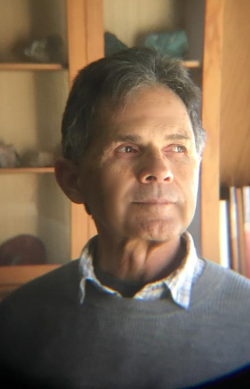Editor’s note: Amigos805 welcomes local guest columns, letters to the editor and other submissions from our readers. All opinions expressed in submitted material are those of the author and do not necessarily represent the viewpoint of Amigos805.
 By David Magallanes • Guest contributor
By David Magallanes • Guest contributor
A number of years ago, I was pursuing a college degree in liberal arts at Oxnard College (OC). I wanted to soften the sharp edges of the decades of technical education that I had acquired up to that point. The classes that I took at OC imparted to me a vision of the world that no physics, math, or engineering class could ever have given me.
Some of my most cherished classes in the liberal arts program taught me to appreciate poetry. Those classes in poetry were taught by one of my colleagues, English professor Shelley Savren.
One of the poems that deeply impressed and mesmerized me was Mary Oliver’s Wild Geese. It conveys sheer, unvarnished truths—the ones that are not easy to confront and that we don’t want to admit are relevant to our lives.
In her poem, Ms. Oliver speaks of our encumbered lives, with their daily concerns and despair. As we struggle with cultural norms and conventions and bemoan our lot in life, all of nature around us carries on. With uninterrupted purpose, it glorifies the underlying source of its existence. The wild geese, flying overhead, call to us to revel in our shared natures.
I was reminded of this epic poetry a couple of weeks ago as a friend and I stood entranced by the flight of American white pelicans over the city of Ventura. It was like watching a dance that had been adroitly choreographed by a master of the art. Some 30 or 40 of the pelicans flew in near-perfect spiraling circles for what seemed like forever.
They appeared to move as of one mind, all soaring at the same orientation until they would suddenly shift angles in unison. They were not unlike the rings of Saturn that seem to “vanish,” as seen from earth, when the planet’s angle renders the astronomically paper-thin rings invisible to us. In similar fashion, the pelicans’ wings and bodies would synchronously appear edgewise and resemble, just for an instant, a compact group of wavy lines. Then, just as suddenly, all the wing surfaces faced us and gave us a glimpse of the birds’ majesty and power as they resumed their circular sojourn.
Mary Oliver teaches us that as we grapple with our pandemics, wars, religions and prejudices, our personal challenges and tragedies, all of nature perpetually manifests its great mysteries and invites us to share in its grandeur.
— Writing services are offered at my website, David Magallanes Writing Services. David Magallanes is a retired college math educator.
***
Gansos Salvajes y Pelícanos Blancos
Por David Magallanes • Columnista invitado
Hace algunos años, me decidí a estudiar las artes liberales en Oxnard College (OC). Quería suavizar los bordes afilados de las décadas de educación técnica que había adquirido hasta ese momento. Las clases que tomé en OC me impartieron una visión del mundo que ninguna clase de física, matemáticas o ingeniería pudiera haberme dado.
Algunas de mis clases más apreciadas en el programa de artes liberales me enseñaron a apreciar la poesía. Esas clases de poesía fueron impartidas por una de mis colegas, la profesora de inglés Shelley Savren.
Uno de los poemas que me impresionó profundamente y me hipnotizó fue Wild Geese (Gansos Salvajes) de Mary Oliver. Transmite verdades puras y sin adornos, aquellas que no son fáciles de confrontar y que no queremos admitir sean relevantes para nuestras vidas.
En su poema, la Sra. Oliver habla de nuestras vidas agobiadas, con sus preocupaciones diarias y su desesperación. Mientras luchamos con las normas y convenciones culturales y lamentamos nuestra suerte en la vida, toda la naturaleza que nos rodea continúa. Con un propósito ininterrumpido, glorifica la fuente subyacente de su existencia. Los gansos salvajes, volando sobre nuestras cabezas, nos llaman para que nos deleitemos en nuestra naturaleza compartida.
Me acordé de esta poesía épica hace un par de semanas mientras una amiga y yo nos quedamos fascinados por el vuelo de los pelícanos blancos americanos sobre la ciudad de Ventura. Era como ver un baile que había sido coreografiado hábilmente por un maestro del arte. Unos 30 o 40 de los pelícanos volaron en círculos en espiral casi perfectos durante lo que pareció una eternidad.
Parecían moverse como una sola mente, todos volando en la misma orientación hasta que de repente cambiaron de ángulo al unísono. No eran diferentes a los anillos de Saturno que parecen “desvanecerse,” como se ve desde la tierra, cuando el ángulo del planeta hace que los anillos, astronómicamente tan delgados como el papel, sean invisibles para nosotros. De manera similar, las alas y los cuerpos de los pelícanos aparecieron sincrónicamente de costado y se asemejaron, por solo un instante, a un grupo compacto de líneas onduladas. Luego, con la misma rapidez, los pelícanos se inclinaron para mostrar sus alas y nos permitieron ver la majestad y el poder de las aves mientras reanudaban su viaje circular.
Mary Oliver nos enseña que mientras lidiamos con nuestras pandemias, guerras, religiones y prejuicios, nuestros desafíos y tragedias personales, toda la naturaleza manifiesta perpetuamente sus grandes misterios y nos invita a compartir su grandeza.
– – Servicios de escritura se ofrecen en mi sitio web, David Magallanes Writing Services. David Magallanes es un profesor de matemáticas jubilado.
Editor’s note: Amigos805 welcomes comments on stories appearing in Amigos805 and on issues impacting the community. Comments must relate directly to stories published in Amigos805, no spam please. We reserve the right to remove or edit comments. Full name, city required. Contact information (telephone, email) will not be published. Please send your comments directly to frank@amigos805.com
